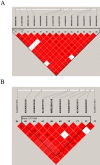Genome-wide association study reveals genetic loci and candidate genes for average daily gain in Duroc pigs
- PMID: 29059722
- PMCID: PMC5838319
- DOI: 10.5713/ajas.17.0356
Genome-wide association study reveals genetic loci and candidate genes for average daily gain in Duroc pigs
Abstract
Objective: Average daily gain (ADG) is an important target trait of pig breeding programs. We aimed to identify single nucleotide polymorphisms (SNPs) and genomic regions that are associated with ADG in the Duroc pig population.
Methods: We performed a genome-wide association study involving 390 Duroc boars and by using the PorcineSNP60K Beadchip and two linear models.
Results: After quality control, we detected 3,5971 SNPs, which included seven SNPs that are significantly associated with the ADG of pigs. We identified six quantitative trait loci (QTL) regions for ADG. These QTLs included four previously reported QTLs on Sus scrofa chromosome (SSC) 1, SSC5, SSC9, and SSC13, as well as two novel QTLs on SSC6 and SSC16. In addition, we selected six candidate genes (general transcription factor 3C polypeptide 5, high mobility group AT-hook 2, nicotinamide phosphoribosyltransferase, oligodendrocyte transcription factor 1, pleckstrin homology and RhoGEF domain containing G4B, and ENSSSCG00000031548) associated with ADG on the basis of their physiological roles and positional information. These candidate genes are involved in skeletal muscle cell differentiation, diet-induced obesity, and nervous system development.
Conclusion: This study contributes to the identification of the casual mutation that underlies QTLs associated with ADG and to future pig breeding programs based on marker-assisted selection. Further studies are needed to elucidate the role of the identified candidate genes in the physiological processes involved in ADG regulation.
Keywords: Average Daily Gain; Duroc Pigs; Genome-wide Association Study (GWAS); Single Nucleotide Polymorphism (SNP).
Conflict of interest statement
We certify that there is no conflict of interest with any financial organization regarding the material discussed in the manuscript. Yang M, Cai G, Wu Z are employees of Guangdong Wens Foodstuffs Co., Ltd..
Figures


References
-
- Xu X, Xing S, Du ZQ, et al. Porcine TEF1 and RTEF1: molecular characterization and association analyses with growth traits. Comp Biochem Physiol B Biochem Mol Biol. 2008;150:447–53. - PubMed
-
- Liu G, Jennen DG, Tholen E, et al. A genome scan reveals QTL for growth, fatness, leanness and meat quality in a Duroc-Pietrain resource population. Anim Genet. 2007;38:241–52. - PubMed
-
- Edwards DB, Ernst CW, Tempelman RJ, et al. Quantitative trait loci mapping in an F2 Duroc x Pietrain resource population: I. Growth traits. J Anim Sci. 2008;86:241–53. - PubMed
-
- Murani E, Muraniova M, Ponsuksili S, Schellander K, Wimmers K. Molecular characterization and evidencing of the porcine CRH gene as a functional-positional candidate for growth and body composition. Biochem Biophys Res Commun. 2006;342:394–405. - PubMed
-
- Harmegnies N, Davin F, De Smet S, et al. Results of a whole-genome quantitative trait locus scan for growth, carcass composition and meat quality in a porcine four-way cross. Anim Genet. 2006;37:543–53. - PubMed
LinkOut - more resources
Full Text Sources
Other Literature Sources

